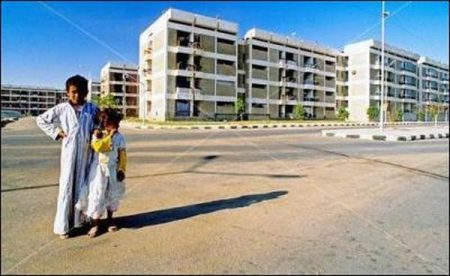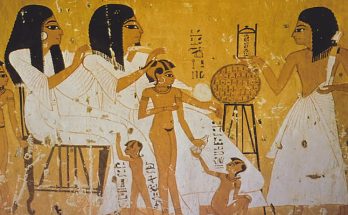The Qena Bend ends at the village of Nag’ Hammadi, where the Nile, which has been running south-southwest from the apex of the bend, turns sharply to the northwest. The Nile valley from here on to the head of the delta is cut in the Eocene limestone plateau and is, for the most part, at its maximum width in Egypt. From here on, also, to within a few miles of Cairo, the river leaves only a narrow strip of flood plain on its east side and in places washes against the base of the bordering cliffs. Most of the arable land is, consequently, west of the river.
Between Nag’ Hammadi and Asyut, a distance by the river of 140 miles (228 km.), the valley is cut through a section of the limestone plateau of almost horizontal structure, and takes the form of a broad, flat-bottomed trough averaging nearly 15 miles wide, known as the Nile ravine.
Precipitous escarpments, rising to a uniform height of nearly 1000 feet above the valley floor and broken only by a few minor wadi mouths, hem it in on each side. By way of one of these wadis on the west side, the 122-mile, narrow-gauge railroad to the Kharga Oasis of the Western Desert enters the valley to connect with the main line a few miles north of Nag’ Hammadi.
The flood plain of the river in this section of the valley is from 10 to 13 miles wide. Served by the Nag’ Hammadi Barrage, the second of the barrages across the Nile below the Aswan Dam, it contains somewhat more than a fourth of the valley’s total acreage of cultivated land. Indeed, it is the most intensively cropped and densely populated section of the valley. The concentration here of six towns nowhere else in Egypt in an area of corresponding size. This section contains all of the province of Girga, Egypt’s most densely populated province, and the almost equally populous southern half of Asyut province.
Cotton and sugar are important cash crops in this section of the valley, and the principal industries of the towns of Girga province are cotton ginning and the production of raw sugar for final refining at the country’s only refinery at Hawamdiya, at the northern end of the valley. Pottery making and cotton spinning and weaving, mainly as cottage and small shop industries, are of considerable importance in all these towns. Akmin is especially noted as a center for hand-loom weaving of wool and silk, as well as of cotton. Nag’ Hammadi, an agricultural village of about 8,000 population, just over the boundary in Qena province, is of interest chiefly as the point where the valley railroad, which parallels the west side of the Nile from Cairo, crosses the river to follow the east side to its terminus at Shallal.
Asyut is the largest city of the valley and its leading industrial and commercial center. Its numerous factory and handicraft industries are a principal source of supply for a large part of the Nile valley. Evidence of its importance as a distribution and marketing center is to be seen in the double tracking of the railroad from Cairo to Asyut. It is connected with the Kharga Oasis of the Western Desert and thence with the Dakhla, Bahariya, and Farafra oases by the famous old caravan track of Darb el Arba’in.
This track continues on from Kharga to northern Sudan; over it, centuries before the building of the valley railroad, ivory and ebony and other cabinet woods were brought up from the Sudan to the craftsmen of Middle Egypt. Asyut is still noted for its inlay work and ivory carving. It was to this section of the valley that the Copts fled from persecution in Roman times and again during the early days of Arab rule. Asyut has a large concentration of Copts.
Visits: 90



